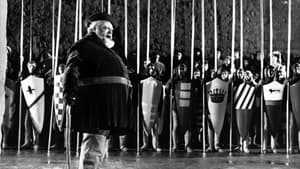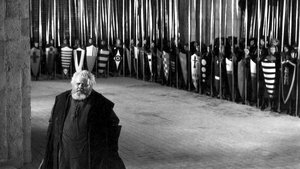Contact: [email protected]
Video Sources 0 Views

Synopsis
[ez-toc]
Introduction
In the enchanting realm of cinema, where every frame is a brushstroke on the canvas of time, the practice of colorizing old films has emerged as a contentious yet captivating endeavor. The notion of breathing new life into classic movies through the infusion of color has sparked debates among purists and film enthusiasts alike. Our journey into this kaleidoscopic landscape brings us to the vibrant adaptation of Orson Welles’ masterpiece, “Chimes at Midnight Colorized 1965,” a cinematic gem that transcends temporal boundaries.
Read Media File Transfer Agreement: Terms and Conditions
Read FAQ
Brief Explanation of Colorization
Colorization, as a process, involves the addition of color to monochrome films, transforming the once black-and-white canvases into vivid spectacles. While this technique has garnered its fair share of criticism for potentially altering the original directorial intent, it opens the door for a contemporary audience to engage with and appreciate the timeless narratives of yesteryear.
Importance of Preserving Old Films
Preserving old films is akin to safeguarding cultural artifacts. These cinematic creations are not merely entertainment; they are windows into bygone eras, capturing the ethos, fashion, and societal norms of their time. Colorization, when executed judiciously, becomes a tool for revitalizing these cinematic treasures, making them more accessible to newer generations who might be deterred by the absence of color.
Introduction to the Topic of Colorized Movies
“Chimes at Midnight Colorized 1965” stands at the crossroads of tradition and innovation, inviting us to explore the impact of colorization on a film that has already left an indelible mark on the annals of cinema.
The History of Chimes at Midnight Colorized (1965)
To understand the significance of the colorized version, we must first revisit the roots of “Chimes at Midnight Colorized.” Directed by the iconic Orson Welles, this 1965 adaptation is a cinematic collage, stitching together various Shakespearean plays to weave a narrative centered around the roguish Sir John Falstaff. Welles’ portrayal of Falstaff is a masterclass in acting, a performance that resonates with the nuances of Shakespearean tragedy and comedy.
Overview of the Film
Set against the medieval backdrop of England, “Chimes at Midnight Colorized” takes us on a journey through political intrigue, betrayal, and honor. The ensemble cast, featuring stalwarts like Jeanne Moreau, Margaret Rutherford, and John Gielgud, contributes to the film’s richness, breathing life into Shakespeare’s timeless characters.
Director and Cast Details
Orson Welles, renowned for his groundbreaking work in “Citizen Kane,” takes on the dual role of director and actor in “Chimes at Midnight Colorized.” His visionary approach to storytelling and his embodiment of Sir John Falstaff elevates the film to a realm of cinematic excellence. The stellar cast, each a luminary in their own right, adds layers of complexity to the narrative, creating a tapestry of emotions that transcends the screen.
Importance of the Film in Its Release Year
Upon its initial release, “Chimes at Midnight Colorized” faced both critical acclaim and commercial challenges. Its significance, however, lies in its bold narrative choices, seamlessly blending Shakespearean plays to craft a cohesive and compelling story. Despite the hurdles, the film has endured as a testament to Welles’ directorial prowess and the timeless appeal of Shakespearean drama.
The Storyline and Plot of Chimes at Midnight Colorized
The plot of “Chimes at Midnight Colorized” is a magnum opus of storytelling, interweaving Shakespeare’s plays, primarily “Henry IV” and “Henry V.” The central figure, Sir John Falstaff, a charismatic and roguish character, becomes the focal point around which the intricate tapestry of political machinations and personal betrayals unfolds.
Synopsis of the Film’s Plot
The narrative begins with Falstaff’s exploits, navigating the corridors of medieval England’s power structures. As political tensions escalate, Falstaff finds himself entangled in a web of deceit and honor, leading to a poignant exploration of friendship and betrayal. The film’s pacing and narrative complexity contribute to its enduring appeal, showcasing Welles’ adeptness at handling Shakespearean material.
Main Characters and Their Roles
Welles’ portrayal of Falstaff is a tour de force, capturing the character’s larger-than-life persona and vulnerability. Jeanne Moreau’s presence as Doll Tearsheet, Margaret Rutherford as Mistress Quickly, and John Gielgud as Henry IV complement Welles’ performance, creating a synergy that propels the narrative forward. Each character, meticulously crafted and portrayed, adds layers of depth to the overall story.
Musical Elements in the Film
While not a musical in the traditional sense, “Chimes at Midnight Colorized” incorporates music as a narrative device. The film’s soundtrack, composed by Angelo Francesco Lavagnino, enhances the emotional impact of key scenes. The use of music, both diegetic and nondiegetic, adds a layer of richness to the cinematic experience, underscoring the emotional beats of the narrative.
The Significance of Ragtime Music and Irving Berlin Songs in the Film
To understand the cultural and historical context of “Chimes at Midnight Colorized,” it is essential to explore the musical elements that permeate the film. While the movie itself doesn’t delve into ragtime music, it is crucial to acknowledge the broader impact of this genre on cinematic storytelling.
Historical Background of Ragtime Music
Ragtime, a musical genre characterized by its syncopated rhythms, emerged in the late 19th century. Its influence on popular music and dance during the early 20th century is undeniable. While not directly featured in “Chimes at Midnight Colorized,” the historical backdrop of ragtime music provides a sonic context that reverberates through the era in which the film is set.
Impact of Swing Music During That Era
The film’s timeline, set in medieval England, predates the swing music era by several centuries. However, the mention of swing music prompts a reflection on its cultural significance during the 1930s and 1940s. Swing, with its infectious rhythms and energetic arrangements, became a cultural phenomenon, influencing not only music but also dance and fashion.
Controversy Surrounding the Plagiarism Lawsuit Against Irving Berlin’s Songs in the Film
Irving Berlin, a legendary composer and songwriter, contributed immensely to the American musical landscape. While not directly associated with “Chimes at Midnight Colorized,” it is essential to touch upon the controversy surrounding a plagiarism lawsuit against Berlin. Accusations of unauthorized use of a theme from his song “Alexander’s Ragtime Band” in the film led to a legal battle. The outcome of this lawsuit underscored the complexities of intellectual property in the realm of filmmaking.
Recognition at the Academy Awards
Despite the legal challenges, “Chimes at Midnight Colorized” received recognition at the Academy Awards, further solidifying its place in cinematic history. The film’s nomination for Best Costume Design reflects the meticulous attention to detail in capturing the visual aesthetics of the medieval period.
The Colorization Process and Its Impact on Chimes at Midnight Colorized
The decision to colorize “Chimes at Midnight Colorized” is a nuanced exploration of balancing tradition with modernity. Colorization, as a process, has its proponents and critics. While purists argue that altering the original black-and-white aesthetic compromises the director’s vision, advocates see it as a means to rejuvenate classic films for contemporary audiences.
Explanation of the Colorization Process
The colorization process involves digitally adding color to each frame of a black-and-white film. This meticulous procedure requires attention to detail to ensure that the colors chosen align with the intended visual atmosphere. For “Chimes at Midnight Colorized,” the colorization process aimed to enhance the film’s visual appeal without overshadowing the directorial and acting brilliance of Welles and the ensemble cast.
Benefits and Drawbacks of Colorizing Old Movies
Colorization, when executed with care, can breathe new life into old films. It allows audiences to engage with the material in a way that feels more immediate and relatable. Colors can enhance the emotional impact of scenes and provide a more immersive viewing experience. However, the process is not without its drawbacks. Critics argue that colorization may distort the original artistic intent, leading to a loss of the intended mood and atmosphere.
Preservation Efforts Through Colorization
In defense of colorization, proponents argue that it serves as a form of preservation. By introducing color to classic films, there is a potential to attract new audiences who might otherwise be disinterested in black-and-white cinema. This accessibility ensures that cinematic treasures are not consigned to the dusty shelves of film archives but remain vibrant and relevant in the digital age.
The Legacy of Chimes at Midnight Colorized and Its Cultural Impact
“Chimes at Midnight Colorized” extends its influence far beyond the silver screen, leaving an indelible mark on various art forms and cultural phenomena. The film’s legacy speaks to its timelessness, inviting adaptations and spin-offs that continue to captivate audiences across different mediums.
Adaptations and Spin-Offs Inspired by the Film
The enduring appeal of “Chimes at Midnight Colorized” has led to various adaptations and spin-offs. Stage productions, drawing inspiration from Welles’ cinematic vision, bring the Shakespearean narrative to live audiences. These adaptations serve as a testament to the enduring power of storytelling that transcends the boundaries of the medium.
Influence on Radio Programs and Broadcasts During That Time Period
During the film’s release era, radio was a prominent medium for entertainment and information. The resonance of “Chimes at Midnight Colorized” extended to radio programs and broadcasts, where the narrative found a new dimension through audio storytelling. The influence of the film on radio adaptations speaks to its ability to transcend visual mediums and capture the imagination of diverse audiences.
Exploring Other Colorized Movies and Their Reception
As we traverse the cinematic landscape colored by the brushstrokes of innovation, it is essential to broaden our scope and explore other instances of colorized films. The reception of colorization, both positive and negative, provides insight into the evolving tastes and preferences of audiences.
Overview of Other Colorized Movies from Different Eras
Colorization is not a recent phenomenon; it has been applied to films spanning various eras. Classic comedies, epic dramas, and iconic musicals have undergone the transformation, inviting audiences to experience these narratives in a new light. The decision to colorize films is often driven by a desire to introduce timeless stories to contemporary audiences who may be less inclined to engage with black-and-white cinema.
Comparison Between the Colorized and Original Versions
The comparison between colorized and original versions raises questions about artistic integrity and audience reception. Purists argue that the original black-and-white aesthetic preserves the intended mood and atmosphere, while colorization advocates emphasize the enhanced visual appeal and accessibility. Analyzing specific examples of colorized films allows us to discern the impact of this transformative process on cinematic storytelling.
Audience Reception and Opinions on Colorization
The reception of colorized films varies among audiences. Some embrace the opportunity to experience classic narratives in a visually enhanced manner, while others remain staunch defenders of the original black-and-white aesthetic. The diverse opinions reflect the evolving nature of cinematic consumption and the ongoing dialogue between tradition and innovation.
Analyzing the Visuals and Fashions in Chimes at Midnight
Colorization not only breathes new life into narratives but also accentuates the visual aesthetics and fashions depicted in classic films. “Chimes at Midnight,” with its medieval setting, becomes a canvas for exploring costume design, cinematography techniques, and the overall visual appeal.
Costume Design and Fashion Trends
The meticulous costume design in “Chimes at Midnight” transports viewers to medieval England, capturing the regality of the court and the rustic simplicity of the common folk. The colorization process accentuates the vibrancy of fabrics and the intricacies of period-appropriate attire. The visual impact of these costumes becomes more pronounced, allowing audiences to appreciate the craftsmanship and attention to detail.
Discussion on Visual Aesthetics and Cinematography Techniques
Beyond costumes, the colorization of “Chimes at Midnight” enhances the overall visual aesthetics and cinematography techniques. The use of color breathes life into the settings, from grand palaces to humble taverns. Cinematographic nuances, such as lighting and framing, take on new dimensions with the introduction of color, creating a visual tapestry that engages the senses.
Movie Review: Chimes at Midnight (Colorized Version)
Having traversed the historical, artistic, and cultural dimensions of “Chimes at Midnight Colorized 1965,” it is time to delve into a critical evaluation of the film in its chromatic incarnation. This review aims to dissect the strengths and weaknesses of the colorized version, offering a nuanced perspective on the viewing experience.
French Language Plot Outline
As part of the global appeal of “Chimes at Midnight,” the inclusion of a French language plot outline enhances accessibility for a broader audience. Language barriers dissolve as the narrative unfolds in a linguistic tapestry that adds yet another layer of inclusivity to the viewing experience.
Evaluation of the Colorized Version
The colorized rendition of “Chimes at Midnight” succeeds in rejuvenating the film for a modern audience. The infusion of color breathes vitality into Welles’ medieval tapestry, adding a layer of realism that enhances the visual experience. The French language plot outline ensures a more inclusive global viewership, breaking down linguistic barriers.
Analysis of Strengths and Weaknesses
The strengths of the colorized version lie in its ability to attract new audiences and provide a fresh perspective on Welles’ directorial brilliance. The infusion of color accentuates the visual aesthetics and costume design, inviting viewers into the heart of medieval England. However, it is essential to acknowledge the potential drawbacks, including concerns about altering the original artistic intent and the ongoing debate surrounding the necessity of colorization.
Personal Opinion on the Viewing Experience
As a viewer, the experience of watching “Chimes at Midnight Colorized 1965” is a journey through time that bridges the gap between the past and the present. The infusion of color does not diminish the film’s timeless narrative but rather adds a layer of accessibility for a new generation of cinephiles. The visual vibrancy, coupled with the linguistic inclusivity, creates a cinematic experience that is both immersive and culturally enriching.
Conclusion
In the grand symphony of cinematic history, “Chimes at Midnight Colorized 1965” emerges as a vibrant note that resonates with the echoes of the past while harmonizing with the sensibilities of the present. The colorization of classic films, when approached with respect for the original vision, becomes a portal through which audiences can traverse temporal landscapes and connect with the timeless narratives of bygone eras.
Final Thoughts on the Significance of Colorized Movies in Preserving Cinematic History
As we bid adieu to the colorized corridors of “Chimes at Midnight,” the broader conversation about colorized movies and their role in preserving cinematic history lingers. The debate between purists and advocates rages on, but one cannot deny the significance of this practice in making classic films more accessible and relevant. “Chimes at Midnight Colorized 1965” exemplifies the delicate dance between tradition and innovation, inviting us to embrace the spectrum of cinematic expression and celebrate the enduring magic of the silver screen























